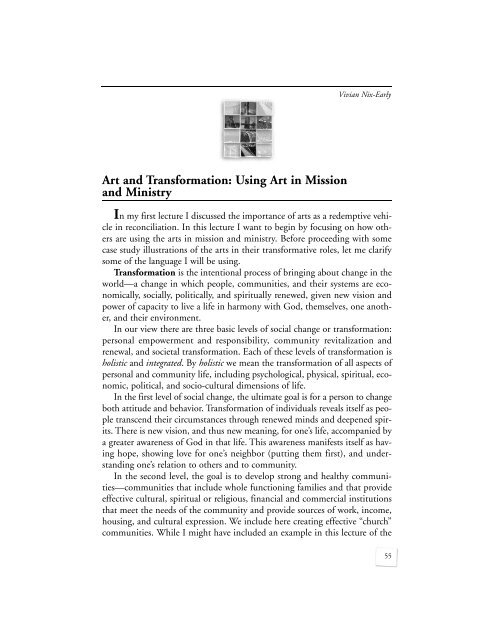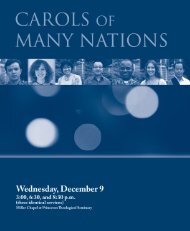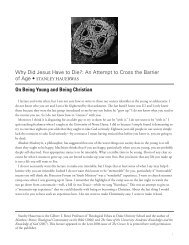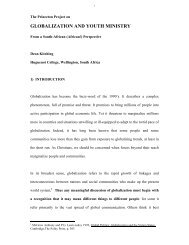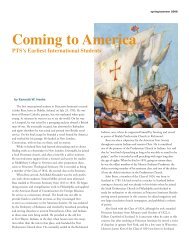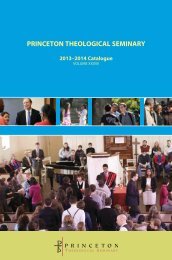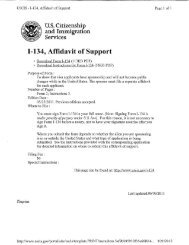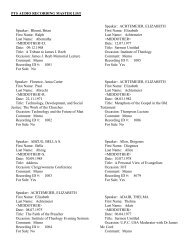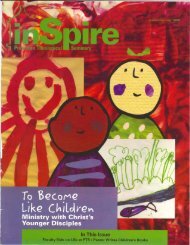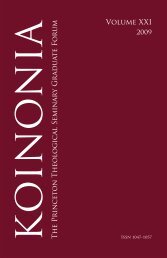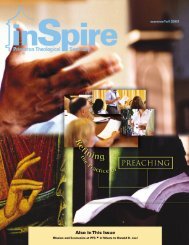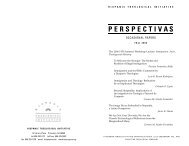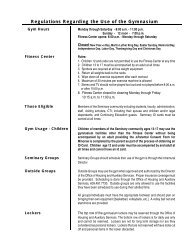Art and Transformation: Using Art in Mission and Ministry
Art and Transformation: Using Art in Mission and Ministry
Art and Transformation: Using Art in Mission and Ministry
Create successful ePaper yourself
Turn your PDF publications into a flip-book with our unique Google optimized e-Paper software.
Vivian Nix-Early<strong>Art</strong> <strong>and</strong> <strong>Transformation</strong>: <strong>Us<strong>in</strong>g</strong> <strong>Art</strong> <strong>in</strong> <strong>Mission</strong><strong>and</strong> M<strong>in</strong>istryIn my first lecture I discussed the importance of arts as a redemptive vehicle<strong>in</strong> reconciliation. In this lecture I want to beg<strong>in</strong> by focus<strong>in</strong>g on how othersare us<strong>in</strong>g the arts <strong>in</strong> mission <strong>and</strong> m<strong>in</strong>istry. Before proceed<strong>in</strong>g with somecase study illustrations of the arts <strong>in</strong> their transformative roles, let me clarifysome of the language I will be us<strong>in</strong>g.<strong>Transformation</strong> is the <strong>in</strong>tentional process of br<strong>in</strong>g<strong>in</strong>g about change <strong>in</strong> theworld—a change <strong>in</strong> which people, communities, <strong>and</strong> their systems are economically,socially, politically, <strong>and</strong> spiritually renewed, given new vision <strong>and</strong>power of capacity to live a life <strong>in</strong> harmony with God, themselves, one another,<strong>and</strong> their environment.In our view there are three basic levels of social change or transformation:personal empowerment <strong>and</strong> responsibility, community revitalization <strong>and</strong>renewal, <strong>and</strong> societal transformation. Each of these levels of transformation isholistic <strong>and</strong> <strong>in</strong>tegrated. By holistic we mean the transformation of all aspects ofpersonal <strong>and</strong> community life, <strong>in</strong>clud<strong>in</strong>g psychological, physical, spiritual, economic,political, <strong>and</strong> socio-cultural dimensions of life.In the first level of social change, the ultimate goal is for a person to changeboth attitude <strong>and</strong> behavior. <strong>Transformation</strong> of <strong>in</strong>dividuals reveals itself as peopletranscend their circumstances through renewed m<strong>in</strong>ds <strong>and</strong> deepened spirits.There is new vision, <strong>and</strong> thus new mean<strong>in</strong>g, for one’s life, accompanied bya greater awareness of God <strong>in</strong> that life. This awareness manifests itself as hav<strong>in</strong>ghope, show<strong>in</strong>g love for one’s neighbor (putt<strong>in</strong>g them first), <strong>and</strong> underst<strong>and</strong><strong>in</strong>gone’s relation to others <strong>and</strong> to community.In the second level, the goal is to develop strong <strong>and</strong> healthy communities—communitiesthat <strong>in</strong>clude whole function<strong>in</strong>g families <strong>and</strong> that provideeffective cultural, spiritual or religious, f<strong>in</strong>ancial <strong>and</strong> commercial <strong>in</strong>stitutionsthat meet the needs of the community <strong>and</strong> provide sources of work, <strong>in</strong>come,hous<strong>in</strong>g, <strong>and</strong> cultural expression. We <strong>in</strong>clude here creat<strong>in</strong>g effective “church”communities. While I might have <strong>in</strong>cluded an example <strong>in</strong> this lecture of the55
Vivian Nix-Earlyarts <strong>in</strong> holistic community development, I have chosen to relate an exampleof renewal of a church community, given the example’s direct relevance towork<strong>in</strong>g with today’s urban youth.In the third level, the goal is the renew<strong>in</strong>g of social systems to be just—the br<strong>in</strong>g<strong>in</strong>g about of fair <strong>and</strong> equitable treatment of all citizens throughpolicy change <strong>and</strong> what we know as social justice; <strong>and</strong> the realization of abetter quality of life <strong>in</strong> relation to others. This <strong>in</strong>volves changes <strong>in</strong> political,economic, technological, <strong>and</strong> social systems created by people for the governanceof a society.The three levels <strong>and</strong> the various aspects of life are <strong>in</strong>terrelated <strong>in</strong> an ecologyof transformation. That is, by chang<strong>in</strong>g one aspect, all levels are changedto different degrees. For example, the <strong>in</strong>novation of rap, which began as aprophetic artistic expression (<strong>in</strong>dividual) <strong>and</strong> which drew from black preach<strong>in</strong>g<strong>and</strong> political rhetoric, led to hip-hop culture <strong>in</strong> urban communities (community)<strong>and</strong> eventually impacted our U.S. <strong>and</strong> <strong>in</strong>ternational culture (societal)with new styles of dress, language, music, <strong>and</strong> changed or re<strong>in</strong>forced values ofyouth. It is a one-billion-dollar <strong>in</strong>dustry, though now considered far from itsorig<strong>in</strong>s <strong>in</strong> both message <strong>and</strong> values.Expressive arts encompass all forms of expressive <strong>and</strong> aesthetic cultureused with<strong>in</strong> formal (that is, concerts, worship services, museums, <strong>and</strong> galleries—oftencalled the f<strong>in</strong>e arts) <strong>and</strong> <strong>in</strong>formal (street, home, community—often called the community arts) contexts.While all creative work is potentially transform<strong>in</strong>g <strong>in</strong> some way, not alltransform<strong>in</strong>g work is redemptive. Redemptive work br<strong>in</strong>gs people <strong>and</strong> communities<strong>in</strong>to a right relationship with God, each other, <strong>and</strong> their environment.Truly transform<strong>in</strong>g work must be redemptive <strong>in</strong> nature.Three Abridged Case StudiesNow let’s exam<strong>in</strong>e three condensed case studies of arts-<strong>in</strong>-action thatbridge various barriers. The first is an illustration of transformation at thepersonal level, bridg<strong>in</strong>g <strong>in</strong>ternal psychological barriers; the second is a casestudy <strong>in</strong>volv<strong>in</strong>g societal change bridg<strong>in</strong>g racial <strong>and</strong> political differences.This is followed by an example of community transformation, with a focuson the church, bridg<strong>in</strong>g church-community, cultural, class, racial, <strong>and</strong> generationalbarriers.56
Vivian Nix-EarlyPersonal <strong>Transformation</strong>—Perfecto!His head was bowed over the white ivory keys <strong>in</strong> silence. His mother,st<strong>and</strong><strong>in</strong>g next to him ready to s<strong>in</strong>g, was sadly still. I could hear every memberof the congregation hold<strong>in</strong>g their breath, a breath that hitched themoment the wrong note was played. Our only question now was, “Whatwould he do next?”Thirteen-year-old Diego was play<strong>in</strong>g <strong>in</strong> his first piano recital before aneighborhood church crowd, hav<strong>in</strong>g recently begun tak<strong>in</strong>g lessons at thechurch-sponsored community center Saturday arts program. He walked to thepiano with pride <strong>and</strong> anticipation. He was to play the first verse of the pieceby himself. He did it—perfecto! He began the second verse, this time with hismother s<strong>in</strong>g<strong>in</strong>g… Oh no! A wrong note. Silence. His mother leaned over towhisper <strong>in</strong> his ear. We all waited <strong>and</strong> prayed that he would beg<strong>in</strong> aga<strong>in</strong>. “Keepgo<strong>in</strong>g,” we wished to ourselves. “Or start over. But just don’t quit!” The motherwhispered aga<strong>in</strong>, <strong>and</strong> yet aga<strong>in</strong> to the frozen boy. We hoped <strong>and</strong> prayed.The keys sounded softly; then stronger. Mother began to s<strong>in</strong>g aga<strong>in</strong> with him.The whole congregation jo<strong>in</strong>ed <strong>in</strong> s<strong>in</strong>g<strong>in</strong>g the third verse. Now <strong>and</strong> aga<strong>in</strong>the piano skipped, but eventually came <strong>in</strong> aga<strong>in</strong>. Everyone stood <strong>and</strong>applauded, attempt<strong>in</strong>g to convey that he should feel the triumph. He did not.Emotional beyond consolation, Diego left the piano bench with a loweredhead, a defeated heart, <strong>and</strong> tears <strong>in</strong> his eyes. He took his seat <strong>and</strong> hid his headbetween his knees.After the recital ended, Diego walked quickly to leave the sanctuary. Icaught him as he rounded the isle with his mother <strong>and</strong> teacher close beh<strong>in</strong>dtry<strong>in</strong>g also to catch him. St<strong>and</strong><strong>in</strong>g <strong>in</strong> his path, I lowered my face to see his.Cupp<strong>in</strong>g his ch<strong>in</strong> <strong>in</strong> my h<strong>and</strong>, I raised his head so that his eyes could see m<strong>in</strong>e.“Diego, don’t you dare be embarrassed or walk with your head down. Youwere the best of everyone tonight because of what you learned. You were verycourageous. When you made a mistake, you learned how to cont<strong>in</strong>ue on afterward.What a wonderful success.”I repeated all these words aga<strong>in</strong> to make sure he heard me. His ever-soslightsmile <strong>and</strong> the now loosen<strong>in</strong>g muscles <strong>in</strong> his face let me know that it wasnot necessary to repeat them a third time. Nodd<strong>in</strong>g heads from teacher <strong>and</strong>mother re<strong>in</strong>forced this truth.I could see Diego from a distance now, a hop <strong>in</strong> his step, engag<strong>in</strong>g with theother kids, his self-esteem restored. His mother found me <strong>and</strong> waited by myside while I ended a conversation with another acqua<strong>in</strong>tance.57
Vivian Nix-Early“I wanted to thank you for what you said to Diego just now. It’s always betterwhen it comes from someone other than me. He would not have been ableto do that three months ago. He would have just crumbled. He’s been work<strong>in</strong>g<strong>in</strong> therapy on this very th<strong>in</strong>g. He’s a perfectionist, <strong>and</strong> when he makes amistake, he falls apart. This is the first time he’s recovered like that.” 1Diego <strong>and</strong> K<strong>in</strong>g Saul share a common remedy—music. In Saul’s case, thebiblical passage implies that it was the <strong>in</strong>herent properties of the music thatwould br<strong>in</strong>g heal<strong>in</strong>g to his recurr<strong>in</strong>g depression. The medium itself acts on theperson, the bra<strong>in</strong>, <strong>and</strong> the heart to br<strong>in</strong>g about health. In Diego’s case it is hisown engagement <strong>in</strong> the process of play<strong>in</strong>g that allows him to overcome hispsychological <strong>and</strong> personality issues.“Do we know that it’s the music that makes the difference <strong>in</strong> your clients’heal<strong>in</strong>g?” we asked Janelle, a licensed music therapist practic<strong>in</strong>g <strong>in</strong>Philadelphia <strong>and</strong> the coord<strong>in</strong>ator of BuildaBridge International’s Community<strong>Art</strong>s Programs.“We don’t always know,” she replied. “But it’s the relationship. That’s whatI tell the volunteer teachers. The music <strong>and</strong> the art are the vehicles to reachkids <strong>and</strong> their families; the vehicle to establish the heal<strong>in</strong>g relationship, particularlywith those clients who are nonverbal.” The music is the bridge’s const ruction material, the teacher <strong>and</strong> student are the builders, <strong>and</strong> therelationship is the bridge.In both these case, the art experience provided the environment for transformationto take place. In the next example we’ll look at how a piece of arthelped br<strong>in</strong>g about, <strong>in</strong> a small but significant way, societal transformation.Societal <strong>Transformation</strong>—Black JesusIn his excellent book Christianity, <strong>Art</strong> <strong>and</strong> <strong>Transformation</strong> South AfricanJohn W. de Gruchy tells the story of the remarkable journey of a pa<strong>in</strong>t<strong>in</strong>g. 2Dur<strong>in</strong>g the apartheid years of South Africa, many Americans were obliviousto the struggle for racial equality <strong>in</strong> that country. Those <strong>in</strong> South Africa knewthat to have America’s support could be <strong>in</strong>strumental <strong>in</strong> chang<strong>in</strong>g power <strong>and</strong>br<strong>in</strong>g<strong>in</strong>g about justice <strong>and</strong> equality.Though his <strong>in</strong>tention may have never been to br<strong>in</strong>g <strong>in</strong>ternational attention,but to pa<strong>in</strong>t the Crucifixion for his context, Cape Town artist RonaldHarold would impact the outcome of apartheid. In 1962, at the time of thefamous Rivonia Trial when Nelson M<strong>and</strong>ela was convicted of treason <strong>and</strong> sentencedto Robb<strong>in</strong>s Isl<strong>and</strong>, Harold pa<strong>in</strong>ted a black Christ be<strong>in</strong>g crucified. The58
Vivian Nix-Earlypa<strong>in</strong>t<strong>in</strong>g was first hung <strong>in</strong> St. Luke’s Anglican Church, <strong>in</strong> Salt River. Whatmade this picture <strong>in</strong>terest<strong>in</strong>g, <strong>and</strong> offensive to some, was that the black Christwas the image of Chief Albert Lutuli <strong>and</strong> the soldier pierc<strong>in</strong>g his side wasPrime M<strong>in</strong>ister Verwoerd.When the Dutch Reformed Church became aware of the pa<strong>in</strong>t<strong>in</strong>g, theylodged an official compla<strong>in</strong>t with the government censorship board because it“offended religious convictions.” Soon it was shown on CBS television <strong>in</strong> theUnited States, <strong>and</strong> it not only raised critical awareness here, but even more sowith the South African government. While the government tried to confiscatethe pa<strong>in</strong>t<strong>in</strong>g, it was secretly smuggled to London where it was sold to raisemoney for the opposition movement, a strategy that was supportive of thework<strong>in</strong>g out of political transformation. Years later, after apartheid ended,there was to be a special celebration <strong>in</strong> Cape Town featur<strong>in</strong>g <strong>Art</strong> <strong>and</strong>Apartheid. Though he didn’t have the pa<strong>in</strong>t<strong>in</strong>g at the time, Harold located thepa<strong>in</strong>t<strong>in</strong>g <strong>in</strong> London <strong>and</strong> returned it to South Africa where it now celebrates 3significance at the National Gallery <strong>and</strong> provides a memory of the past.While Harold’s goal may not have been to help transform his society, butmerely to comment on it, his Crucifixion, a prophetic piece of art, became apart of the movement <strong>and</strong> the work<strong>in</strong>g out of South Africa’s political transformation.A goal of justice <strong>and</strong> equality <strong>in</strong> society is to see the aestheticexpressions of all cultures valued <strong>and</strong> recognized by the government. A key<strong>in</strong>dicator of the success of this goal is the <strong>in</strong>creased number, space, <strong>and</strong> recognitiongiven to art of all cultures <strong>in</strong> public places. Has redemptive transformationoccurred? Is South Africa mov<strong>in</strong>g toward the NU JERUZ? Certa<strong>in</strong>lythis is one <strong>in</strong>dication that it is.Community <strong>Transformation</strong>—Rap <strong>and</strong> the Reality of the NU JERUZAgh! Agh! ChiAgh Agh!” The street was <strong>in</strong> the church, if one would call ita church. Many pastors wouldn’t, <strong>and</strong> several compla<strong>in</strong> on a monthly basis.But one could not mistake the symbols of Hip-Hop culture as turntablesturned, rappers rapped, <strong>and</strong> B-boys break danced <strong>in</strong> a “sanctuary” that rockedmore like a ghetto city street club on Saturday night than a Thursday nightyouth church service <strong>in</strong> northern Tampa. But make no mistake about it,Pastor Tommy Kyllonen (a.k.a. Urban D) is serious about reach<strong>in</strong>g multiculturalyouth addicted to hip-hop, marg<strong>in</strong>alized by the traditional church, <strong>and</strong><strong>in</strong> need of a “relationship with Christ.” The sign for Crossover (the name of59
Vivian Nix-Earlythe church) is a colorful graffiti pa<strong>in</strong>t<strong>in</strong>g of the name amplified by a parkedvan bear<strong>in</strong>g another graffiti render<strong>in</strong>g of “Jesus Saves.”The front of the church “stage” is a full-wall graffiti mural with a contextualizedsalvation theme, <strong>and</strong> if you don’t look closely, you’ll miss the rejoic<strong>in</strong>gangel <strong>in</strong> heaven that’s break danc<strong>in</strong>g with a head-sp<strong>in</strong> move. Theback-center floor area is a polished hardwood square specifically for breakdance rejoic<strong>in</strong>g. And two graffiti pa<strong>in</strong>ted vans sit outside <strong>in</strong> the gravel park<strong>in</strong>garea ready for runs through the community to transport the young worshipersto <strong>and</strong> from <strong>in</strong> style.We walked <strong>in</strong>to Crossover Church <strong>and</strong> were <strong>in</strong>troduced to “Urban D,”“Z,” “Spec,” “Nice,” <strong>and</strong> “Fat Daddy.” What were they say<strong>in</strong>g? “Show yourneighbor some love <strong>and</strong> say wuz up!” (that is, greet your neighbor). “Yo, hookus up. Get us off.” (like the two thieves would have said to Jesus on the cross).These were the unfamiliar words <strong>and</strong> sounds to some very familiar worshiptraditions <strong>and</strong> Scripture that Pastor Tommy was expla<strong>in</strong><strong>in</strong>g <strong>in</strong> the style <strong>and</strong>l<strong>in</strong>go of the hip-hop crowd sitt<strong>in</strong>g <strong>in</strong> front of him for the now regular,st<strong>and</strong><strong>in</strong>g-room-only, hip-hop youth service held every Thursday night atCrossover Church <strong>in</strong> Tampa, Florida. With the sound turned down, youmight have thought you’d walked <strong>in</strong>to a concert by the rap group NAS. Thetypical “wave your h<strong>and</strong>s <strong>in</strong> the air” <strong>and</strong> “jump<strong>in</strong>’ straight up” movements ofhip-hop artists <strong>and</strong> fans was go<strong>in</strong>g on. But with the sound turned up, it wasjust a different k<strong>in</strong>d of praise.An hour before, Pastor Tommy was hold<strong>in</strong>g his first “new members” classfor this grow<strong>in</strong>g church that is respond<strong>in</strong>g to <strong>and</strong> reach<strong>in</strong>g unchurched <strong>and</strong>Christian young people grow<strong>in</strong>g up <strong>in</strong> the MTV-BET world. Pastor Tommyis educat<strong>in</strong>g a spiritually uneducated audience by contextualiz<strong>in</strong>g the gospel.He’s keep<strong>in</strong>g it simple <strong>and</strong> keep<strong>in</strong>g it “real.”“I want these young people to have a relationship with Christ.” The lean<strong>and</strong> youthful Pastor Tommy shared with conviction. “I want to reach peoplewho would not attend other churches or who might not be accepted. I wantto do it <strong>in</strong> the language of the culture, the hip-hop culture.”Letters <strong>and</strong> e-mails come every month from traditional churches. Theirpastors tell him <strong>and</strong> the other leaders of Crossover to stop what they’re do<strong>in</strong>g.(Note the status barrier be<strong>in</strong>g illustrated here by traditional churches.) But hewas lett<strong>in</strong>g the newest recruits know: “We are a real church, not a club! Wefollow the Bible.” And everyth<strong>in</strong>g that followed—the Thursday service, theCommunion observance, the <strong>in</strong>terviews with his staff <strong>and</strong> congregation—60
Vivian Nix-Earlyproved it. The gospel is expressed <strong>and</strong> taught through the music of the city, itsdance, <strong>and</strong> art forms, all without compromis<strong>in</strong>g the message of truth or thewalk of the leaders.And it is work<strong>in</strong>g as well, as he br<strong>in</strong>gs some critical awareness to the churchthat is fail<strong>in</strong>g this particular segment of the community. From just a fewyoung people to several hundred now, Pastor Tommy <strong>and</strong> a multiethnic leadershipcrew serve this small church nestled <strong>in</strong> a lazy residential section ofTampa. They br<strong>in</strong>g youth from all over the city <strong>in</strong>to a community that nurtures,loves, <strong>and</strong> encourages them <strong>in</strong>to a community of believers, provid<strong>in</strong>g ahaven of the k<strong>in</strong>gdom for those lost <strong>in</strong> an urban world of drugs, violence, <strong>and</strong>dysfunctional families. The church has recently begun to confront the socialissues raised by the youth, AIDS, child molestation, <strong>and</strong> abortion.Not concerned about hair color, ethnicity (Tommy himself is aPhiladelphia Greek married to a New York Puerto Rican), social class, ordenom<strong>in</strong>ation, Crossover shares the concerns of a grow<strong>in</strong>g number ofChristians <strong>in</strong> the United States: how do we reach those who the church hasneglected, society has marg<strong>in</strong>alized, <strong>and</strong> Satan has trampled?“Urban D” is Tommy Kyllonyn’s nationally known record<strong>in</strong>g name. But atCrossover <strong>and</strong> <strong>in</strong> the neighborhood, the young people <strong>and</strong> their parents hughim <strong>and</strong> know him as Pastor Tommy. At either place, though, his message isthe same. Tommy is no lightweight. He’s authentic <strong>and</strong> comes not only withthe credibility of know<strong>in</strong>g <strong>and</strong> liv<strong>in</strong>g the hip-hop culture but with a solid biblical<strong>and</strong> theological background. Kyllonen is a college graduate with a concentration<strong>in</strong> youth m<strong>in</strong>istry. But much of Tommy’s preparation for hisunconventional church <strong>and</strong> pastor<strong>in</strong>g came as a white boy grow<strong>in</strong>g up <strong>in</strong> hisrough Philadelphia environment.We learned from Tommy that hip-hop is spiritual. It is a spiritual language<strong>in</strong>fused with the language of the street but conta<strong>in</strong><strong>in</strong>g the mean<strong>in</strong>g of thegospel. He is mak<strong>in</strong>g worship relevant to an audience that found no mean<strong>in</strong>g<strong>in</strong> the traditional church. And he has a leadership style that <strong>in</strong>corporates thearts <strong>and</strong> artists <strong>in</strong> every possible medium to celebrate renewal.C o n s t ruct<strong>in</strong>g the Bridge with the <strong>Art</strong>s: Challenges <strong>and</strong>Pr<strong>in</strong>ciples for a NU JERUZThe arts are a way to br<strong>in</strong>g about the NU JERUZ, <strong>and</strong> they ga<strong>in</strong> <strong>in</strong> effectivenesswhen they are a part of a holistic approach to meet<strong>in</strong>g people’s needs.The goal is not to just cross the boundaries or “underst<strong>and</strong>” or “appreciate” or61
Vivian Nix-Early“value” diversity. We must move toward susta<strong>in</strong>ed relationship <strong>in</strong> pursuit ofGod’s k<strong>in</strong>gdom on earth, <strong>and</strong> we must cross our own <strong>in</strong>ternal barriers to doso. The artists themselves cross/bridge their own <strong>in</strong>ternal barriers of self, ego,pride, status, <strong>and</strong> power <strong>and</strong> f<strong>in</strong>d God <strong>in</strong> themselves through the process ofart-mak<strong>in</strong>g with others when that art-mak<strong>in</strong>g is motivated by an agape love.The challenge to the church is to build true multiethnic communities. AndI don’t mean allow<strong>in</strong>g our build<strong>in</strong>gs to be used by other non-English, non-likeuscongregations to worship at a different time than the ma<strong>in</strong> congre g a t i o n .The church has a particular m<strong>and</strong>ate for, <strong>and</strong> power to accomplish, reconciliation.As stated succ<strong>in</strong>ctly by Manuel Ortiz, “The church’s task is neitherto destroy nor to ma<strong>in</strong>ta<strong>in</strong> ethnic identities but to replace them with a newidentity <strong>in</strong> Christ that is more fundamental than earthly identities.” 4 This isthe advantage that faith has over the secular programs that aim at racial reconciliation.There is <strong>in</strong> fact another exist<strong>in</strong>g community <strong>in</strong> the fullest mean<strong>in</strong>gof the word—shared values, shared history, shared goals, <strong>and</strong> sharedidentity—to which people from diverse backgrounds show allegiance.“Whether a person likes it or not, the same act that reconciles one to Godsimultaneously <strong>in</strong>troduces the person <strong>in</strong>to a community where people f<strong>in</strong>dtheir identity <strong>in</strong> Jesus Christ rather than <strong>in</strong> their race, culture, social class, orsex, <strong>and</strong> are consequently reconciled to one another. The unifier is Jesus Christ<strong>and</strong> the unify<strong>in</strong>g pr<strong>in</strong>ciple is the ‘Gospel’” 5To Ortiz, there is both a qualitative <strong>and</strong> quantitative dimension of the multiethnicchurch. In the quantitative def<strong>in</strong>ition there must be a significantnumber of people from different ethnicities, not a “smatter<strong>in</strong>g of one cultureor another.” 6 The qualitative dimension has to do not only with the life <strong>and</strong>organization of the church but also with its commitment to matters of reconciliation<strong>and</strong> justice. Ortiz offers some basic pr<strong>in</strong>ciples for establish<strong>in</strong>g whathe calls “Build<strong>in</strong>g a New Humanity.” 7Ortiz lists five important pr<strong>in</strong>ciples for develop<strong>in</strong>g the New Humanity(1 Cor<strong>in</strong>thians 12:13).1. Declare <strong>in</strong> written form the biblical position of the church on thismatter of unity <strong>in</strong> diversity.2. Develop a mission statement that will assist the church <strong>in</strong> itsfocus to do m<strong>in</strong>istry that is effectual <strong>in</strong> the context of a multiethniccommunity.62
Vivian Nix-Early3. Develop a philosophy of m<strong>in</strong>istry that will put the mission statement<strong>in</strong>to action.4. Involve multiethnic leaders <strong>in</strong> the process.5. Be deliberate <strong>in</strong> determ<strong>in</strong><strong>in</strong>g how to resolve conflicts.The ultimate goal of a multicultural church is not multiculturalism for itsown sake (quantitative) but a genu<strong>in</strong>e community <strong>in</strong> which all seek justice,peace, <strong>and</strong> reconciliation <strong>in</strong> structure, m<strong>in</strong>istry, <strong>and</strong> worship toward the commongoal of the NU JERUZ.Based upon our re s e a rch, we suggest some pr<strong>in</strong>ciples used by multiculturalc o n g regations <strong>in</strong> both their work<strong>in</strong>g out <strong>and</strong> their celebrat<strong>in</strong>g re c o n c i l i a t i o n .The Hug. Congregations must “create a friendly space” for diversity <strong>and</strong><strong>in</strong>clude those outside the sanctuary. The best example of this comes from APlace Called Hope <strong>in</strong> Miami, Florida. Here visitors <strong>and</strong> worshipers are metwith full hugs <strong>and</strong> cheek kisses by four greeters vary<strong>in</strong>g <strong>in</strong> ethnic <strong>and</strong> faith persuasionsas they enter the expansive converted worship center <strong>in</strong> a local stripshopp<strong>in</strong>g mall.The Rap. The congregations we visited created a worship celebration thatmet the spiritual needs of the worshipers <strong>and</strong> the social needs of the community.For Urban D (Tommy Kyllonen) it is hip-hop for an urban-driven youthculture. For Tom Sullivan at Spirit of God Fellowship <strong>in</strong> South Holl<strong>and</strong>,Ill<strong>in</strong>ois, it focuses on the needs of children more used to video games <strong>and</strong>television cartoons than an ancient liturgy. Many of these churches f<strong>in</strong>dthemselves <strong>in</strong> chang<strong>in</strong>g neighborhoods <strong>and</strong> <strong>in</strong>carnationally f<strong>in</strong>d ways tocelebrate renewal <strong>in</strong> the cultural <strong>and</strong> artistic language(s) of the community.They have chosen not to move out but to move on with the k<strong>in</strong>gdom <strong>in</strong>their neighborhoods.The Power <strong>and</strong> the Politic. Creative renewal beg<strong>in</strong>s with leadership.Unless the pastor <strong>and</strong> other church leaders have a vision, creativity, trust, <strong>and</strong>will<strong>in</strong>gness to share power, creative worship cannot <strong>and</strong> will not take place.Part of this formula <strong>in</strong>cludes shar<strong>in</strong>g ethnic power with a diverse group ofm<strong>in</strong>isters as at Arch Street United Methodist <strong>in</strong> Philadelphia, or as <strong>in</strong> ourexample above at A Place Called Hope. Located <strong>in</strong> a chang<strong>in</strong>g communitywith large Catholic <strong>and</strong> Jewish populations, this charismatic PentecostalFlorida congregation has enlisted m<strong>in</strong>isters from these populations. Churcheswith diverse leadership model the k<strong>in</strong>gdom <strong>in</strong> ways that words, statements,<strong>and</strong> policies cannot. Pastors who share their sermon time with other communicativeart forms <strong>and</strong> congregations that are will<strong>in</strong>g to adjust to a new ritual63
Vivian Nix-Earlymay f<strong>in</strong>d true renewal <strong>in</strong> their worship experience. We have observed a leadershipthat is more egalitarian than authoritarian. Leaders of many of theseworship experiences share their power by seek<strong>in</strong>g <strong>in</strong>volvement <strong>and</strong> delegat<strong>in</strong>gresponsibility throughout the participat<strong>in</strong>g congregation.The Creative. Congregations that seek to celebrate <strong>and</strong> experience renewalvalue the arts <strong>and</strong> artists as a gift of God <strong>in</strong> their midst. Their encouragement<strong>and</strong> nurture take a flexibility <strong>and</strong> openness often outside the bounds oftraditional culture. While there are many artists who will give of their timefreely, <strong>and</strong> we support volunteerism, many artists need to earn their liv<strong>in</strong>g byplay<strong>in</strong>g gigs, especially s<strong>in</strong>ce they live without health <strong>in</strong>surance <strong>and</strong> retirementpolicies. Congregations who may not have the benefit of significant f<strong>in</strong>ancialresources for fancy technology <strong>and</strong> state-of-the-art equipment can still takecare not only to provide a creative space for the artist but also to support them<strong>in</strong> other ways. One possible way of do<strong>in</strong>g this would be to barter for time.Provid<strong>in</strong>g church space for a studio or enroll<strong>in</strong>g the artist <strong>in</strong> the staff healthcare plan may speak more loudly than a weekly paycheck. And as we saw atPastor Eric Elnes’s Scottsdale Congregational United Church of Christ <strong>in</strong>Scottsdale, Arizona, even <strong>in</strong>vit<strong>in</strong>g non-Christian artists to experience worshipis a way to witness <strong>and</strong> demonstrate the love of an <strong>in</strong>clusive God.The <strong>Art</strong>s of the Community. In any church we attend, the first signs of adiverse congregation—the first th<strong>in</strong>gs we look for—are the art on the wall <strong>and</strong>the songs listed <strong>in</strong> the bullet<strong>in</strong>. Truly diverse congregations have <strong>in</strong>corporatedthe aesthetic expressions of their diversity. The pa<strong>in</strong>t<strong>in</strong>gs, pictures, banners,songs, dramas, dances, <strong>and</strong> worship styles are symbols of culture. A congregationthat is able to “blend” these <strong>in</strong>to a patchwork of worship has made amajor shift <strong>in</strong> its culture. The ability to release others is a major sign of openness<strong>and</strong> power shar<strong>in</strong>g. And most of us have yet to arrive.New <strong>Art</strong> for a NU JERU Z . We are wait<strong>in</strong>g with anticipation for the emergenceof new authentic arts expressions that are re p re s e n t a t i ve of a NU JERU Z .There is a direct l<strong>in</strong>k between the worship of the church <strong>and</strong> its mission <strong>in</strong>the community. Like Isaiah who received his call out of a holy <strong>and</strong> aestheticworship experience <strong>and</strong> moved <strong>in</strong>to the world to do justice <strong>and</strong> walk humblywith God, 8 the church, through the celebration of the cross <strong>and</strong> the victory itrepresents, sends the congregation to be <strong>in</strong> the world call<strong>in</strong>g, m<strong>in</strong>ister<strong>in</strong>g, <strong>and</strong>be<strong>in</strong>g the presence of Christ <strong>in</strong> the public square. But like the New Testament<strong>in</strong> gather<strong>in</strong>g of the faithful when their voices communicated <strong>in</strong> every knownlanguage, so the church worship is renewed to celebrate the fruits of its labor64
Vivian Nix-Early<strong>in</strong> a diverse world. Without the call there is no send<strong>in</strong>g, without the send<strong>in</strong>gthere is no labor, without the labor there is no harvest, <strong>and</strong> without the harvestthere is no celebration <strong>and</strong> renewal—only tradition bound by culture. 9In summary, successfully jo<strong>in</strong><strong>in</strong>g the ranks of the Agape artists <strong>and</strong> m<strong>in</strong>istersmeans that you will possess:• A call <strong>and</strong> a comm<strong>and</strong>ment from God• A propensity for action• An ability to draw empathy from your own personal pa<strong>in</strong> <strong>and</strong>heartbreak• A goal of redemption through <strong>in</strong>carnational relationship• A will<strong>in</strong>gness to make “out-of-pocket” sacrifices of personalresources of time <strong>and</strong> money• A risky love <strong>and</strong> a compassion for the unloved, the forgotten, therejected, <strong>and</strong> the excluded• A spirit of reconciliation <strong>and</strong> forgiveness across ethnic <strong>and</strong> otherboundaries• An ability to show up faithfully• An ability to know your limits <strong>and</strong> seek rejuvenationA Challenge to <strong>Art</strong>ists: F<strong>in</strong>d<strong>in</strong>g One’s EschatonGod is speak<strong>in</strong>g to us <strong>in</strong> our time. The questions we have to ask are, “Whatis my place <strong>in</strong> the journey of redemptive transformation, <strong>and</strong> what gift hasGod given me to br<strong>in</strong>g about his k<strong>in</strong>gdom <strong>in</strong> the present day?” As AlbertNolan suggests, the event that def<strong>in</strong>es the present—our time <strong>in</strong> the NUJERUZ—is our eschaton. 10 Our eschaton is a time of choice, when we arecompelled to choose to act; it is the call<strong>in</strong>g, the decision, the act of <strong>in</strong>volv<strong>in</strong>gourselves <strong>and</strong> our art <strong>in</strong> redemptive transformation.<strong>Art</strong>ists play a very special role <strong>in</strong> God’s plan for a NU JERUZ. It is the timeof the arts be<strong>in</strong>g recognized as the gift of God—one of his creation tools foradvanc<strong>in</strong>g the k<strong>in</strong>gdom—not <strong>in</strong>side the four walls of the church for only verticalrelationship <strong>and</strong> praise but for expressions of horizontal service to those<strong>in</strong> need. When you build relationships, boundaries are naturally crossed.At a recent series of lectures at a center city church we presented this modelas a way of challeng<strong>in</strong>g artists to become more <strong>in</strong>volved with their art <strong>in</strong>transform<strong>in</strong>g the world. Many artists see their art as a very personal <strong>and</strong> creativeendeavor. Other artists live professional lives <strong>and</strong> have very little time forcommunity activities, especially artists with grow<strong>in</strong>g families. The church too65
Vivian Nix-Earlyhas sometimes been more concerned with the end times than the presenttimes, which allows us to be relieved of the social consequences of our “time”while feel<strong>in</strong>g safe that we have been “saved.”<strong>Art</strong>ists have a unique opportunity to explore <strong>and</strong> enact a m<strong>in</strong>istry that canimpact the world—a world that is at our doorstep, on our street, <strong>and</strong> <strong>in</strong> ourcommunity. It is an opportunity to live the gospel through the shar<strong>in</strong>g of ourart <strong>in</strong> ways that br<strong>in</strong>g critical awareness of the need for change; a shar<strong>in</strong>g lived<strong>in</strong> our compassion for others; <strong>and</strong> a celebration of the victories of life as people<strong>and</strong> communities enter <strong>in</strong>to the NU JERUZ. We as artists can answer thecall of our eschaton through A.R.T.T h rough its Community <strong>Art</strong>s Program <strong>and</strong> its Educational Sa f a r i sProgram, BuildaBridge International provides opportunities for artists to servecommunities <strong>and</strong> people <strong>in</strong> need <strong>in</strong> the tough places of the world, <strong>in</strong>clud<strong>in</strong>gurban cities <strong>in</strong> America. Our current call for artists of the Christian faith <strong>and</strong>those who would be part of what God is do<strong>in</strong>g <strong>in</strong> the world is for work withstreet kids <strong>in</strong> Brazil, Costa Rica, <strong>and</strong> Philadelphia. 11Notes66Let us weep until our tears turn <strong>in</strong>to <strong>in</strong>dignation, our <strong>in</strong>dignation <strong>in</strong>todeterm<strong>in</strong>ation, our determ<strong>in</strong>ation <strong>in</strong>to action, <strong>and</strong> our action <strong>in</strong>to abetter society where our children <strong>and</strong> generations to come can enjoy life,liberty, <strong>and</strong> the pursuit of happ<strong>in</strong>ess. And the Tupac Shakurs need rebelno more <strong>and</strong> can turn their genius to th<strong>in</strong>gs that are beautiful, lovely,<strong>and</strong> good—to the love <strong>and</strong> celebration of life: black <strong>and</strong> white, male<strong>and</strong> female, young <strong>and</strong> old. 121. “Diego” is our name used to protect the identity of the young boy who played <strong>in</strong> the Ayuda Sabbath<strong>Art</strong>s School recital to end the school’s spr<strong>in</strong>g 2002 semester. The recitals, held twice a year, are an importantpart of the SAS program’s goals to celebrate <strong>in</strong>cremental achievements of students, to give opportunitiesfor public practice of social behaviors, <strong>and</strong> to provide affirmation of gifts <strong>and</strong> self-worth. TheAyuda SAS serves a multiethnic population of youth <strong>and</strong> families <strong>in</strong> the North Philadelphia section ofthe city.2. John W. de Gruchy, Christianity, <strong>Art</strong> <strong>and</strong> <strong>Transformation</strong> (Cambridge University Press, 2001).3. The terms critical awareness, work<strong>in</strong>g out, <strong>and</strong> celebration refer to a three-stage change model <strong>and</strong>theory (The <strong>Art</strong>s <strong>in</strong> Redemptive <strong>Transformation</strong>, or A.R.T. Theory) developed by Vivian Nix-Early <strong>and</strong>J. Nathan Corbitt as a result of their research with artists.4. Manuel Ortiz, One New People: Models for Develop<strong>in</strong>g a Multiethnic Church (InterVarsity Press,1996), p. 130.5. Ibid., p. 114.
Vivian Nix-Early6. Ibid., p. 88.7. Ibid., p. 130.8. De Gruchy, p. 253.9. Review a study of this <strong>in</strong> J. Nathan Corbitt, The Sound of the Harvest: Music’s <strong>Mission</strong> <strong>in</strong> Church<strong>and</strong> Culture (Baker Book House, 1998).10. Albert Nolan, Jesus Before Christianity (Mary Knoll, NY: Orbis Books, 2001), p. 171.11. We are always look<strong>in</strong>g for youth groups <strong>in</strong>terested <strong>in</strong> apprentic<strong>in</strong>g as arts missionaries or <strong>in</strong>terested<strong>in</strong> cross<strong>in</strong>g cultural boundaries <strong>and</strong> br<strong>in</strong>g<strong>in</strong>g their faith to life through the arts through travel to work<strong>and</strong> learn with youth <strong>in</strong> other countries. Consult our Web site for more <strong>in</strong>formation(www.buildabridge.org).12. Herbert Daughtry, “Who Will Weep for Tupac? A Pastor’s Dilemma,” Sojourners (March–April1997): p. 36.67


